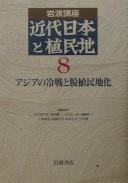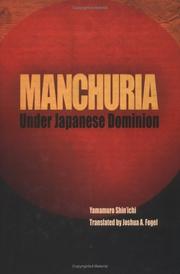| Listing 1 - 10 of 16 | << page >> |
Sort by
|
Book
ISBN: 4000104829 Year: 1995 Publisher: Tōkyō : Iwanami Shoten,
Abstract | Keywords | Export | Availability | Bookmark
 Loading...
Loading...Choose an application
- Reference Manager
- EndNote
- RefWorks (Direct export to RefWorks)
Japan --- Politics and government --- Colonies --- Administration --- History --- J4804 --- J4810.70 --- Japan: International politics and law -- colonial conditions, organization and administration --- Japan: International politics and law -- international relations, policy and security -- Kindai (1850s- ), bakumatsu, Meiji, Taishō
Book
ISBN: 9784901558518 490155851X Year: 2011 Publisher: Kyoto International research center for Japanese studies
Abstract | Keywords | Export | Availability | Bookmark
 Loading...
Loading...Choose an application
- Reference Manager
- EndNote
- RefWorks (Direct export to RefWorks)
Korea --- History --- Politics and government --- Social conditions --- K9171 --- K9170 --- J4804 --- Korea: History -- Japanese annexation period -- annexation (1905-1910) --- Korea: History -- Japanese annexation period (1905-1945) --- Japan: International politics and law -- colonial conditions, organization and administration --- E-books --- K9348 --- K9300.70 --- Korea: Social policy and pathology -- police --- Korea: Social sciences -- social and cultural history -- Japanese annexation period (1905-1945)

ISBN: 4000104853 Year: 1995 Publisher: Tōkyō : Iwanami Shoten,
Abstract | Keywords | Export | Availability | Bookmark
 Loading...
Loading...Choose an application
- Reference Manager
- EndNote
- RefWorks (Direct export to RefWorks)
Colonies --- Administration. --- Japan --- Politics and government --- Administration --- History --- J4804 --- J4810.70 --- J4209 --- Japan: International politics and law -- colonial conditions, organization and administration --- Japan: International politics and law -- international relations, policy and security -- Kindai (1850s- ), bakumatsu, Meiji, Taishō --- Japan: Sociology and anthropology -- communities -- racial and ethnic -- emigrants

ISBN: 4000104861 9784000104869 Year: 1995 Publisher: Tōkyō : Iwanami Shoten,
Abstract | Keywords | Export | Availability | Bookmark
 Loading...
Loading...Choose an application
- Reference Manager
- EndNote
- RefWorks (Direct export to RefWorks)
Japan --- Colonies --- History --- J4804 --- J4810.70 --- J3491.10 --- J3991 --- Japan: International politics and law -- colonial conditions, organization and administration --- Japan: International politics and law -- international relations, policy and security -- Kindai (1850s- ), bakumatsu, Meiji, Taishō --- Japan: Geography and local history -- others -- Asia -- East Asia (colonial) --- Asia: History and geography

ISBN: 0812239121 9780812239126 Year: 2006 Publisher: Philadelphia University of Pennsylvania Press
Abstract | Keywords | Export | Availability | Bookmark
 Loading...
Loading...Choose an application
- Reference Manager
- EndNote
- RefWorks (Direct export to RefWorks)
"From 1932 until the end of World War II, the Japanese established and maintained by bloody rule a puppet regime in the Chinese region of Manchuria. Yamamuro Shin'ichi's extraordinary book rereads this occupation under new light. The author shows that right-wing Japanese military and civilian groups thought of construction in this sparsely populated region as an effort to build a paradise on earth, with roots deep in Asia traditions. At the same time, Chinese and Korean populations in the region were abused by the Japanese military, and many Japanese were deliberately misinformed about what was being done in their name."--Jacket.
Manchuria (China) --- History --- J3385 --- J3491.14 --- J4804 --- S22/0510 --- Japan: History -- Gendai, modern -- Shōwa period -- World War II -- invasion of Asia (1931-1945) --- Japan: Geography and local history -- others -- Asia -- colonial China, Manchuria --- Japan: International politics and law -- colonial conditions, organization and administration --- North-eastern provinces (Manchuria)--Manzuguo
Book
ISBN: 9784866581248 4866581247 Year: 2021 Publisher: Tokyo Japan Publishing Industry Foundation for Culture
Abstract | Keywords | Export | Availability | Bookmark
 Loading...
Loading...Choose an application
- Reference Manager
- EndNote
- RefWorks (Direct export to RefWorks)
From 1910 to 1945, Korea was a colony of Imperial Japan. Its governance has been described politically in terms of harsh oppression and economically as exploitation and impoverishment. Certainly, there were many problems with Japanese rule in Korea, but how accurate are those claims? What is the connection between the post-war development of South Korea and the socialist regime in North Korea? This book focuses on economic issues, sticks to positivism, and depicts the reality and transformation of Korea during the period of Japanese control.
K9400.70 --- J4390.90 --- J4804 --- Korea: Economy and industry -- history -- Japanese annexation period (1905-1945) --- Japan: Economy and industry -- local economic history and geography -- Remote and others --- Japan: International politics and law -- colonial conditions, organization and administration --- Korea --- Japan --- Economic conditions --- Relations --- J4390.9112 --- Japan: Economy and industry -- local economic history and geography -- remote and others -- Asia -- East Asia -- Korea (South) --- Conditions économiques
Book
ISBN: 9780801449260 Year: 2011 Volume: *2 Publisher: Ithaca Cornell university press
Abstract | Keywords | Export | Availability | Bookmark
 Loading...
Loading...Choose an application
- Reference Manager
- EndNote
- RefWorks (Direct export to RefWorks)
J3374 --- J4000.80 --- J4122 --- J4804 --- Japan: History -- Kindai, modern -- Meiji period (1868-1912) -- imperial expansion --- Japan: Social history, history of civilization -- Gendai (1926- ), Shōwa period, 20th century --- Japan: Sociology and anthropology -- nationalism --- Japan: International politics and law -- colonial conditions, organisation and administration --- Bureaucracy --- Civil-military relations --- Fascism --- Technological innovations --- Military and civilian power --- Military-civil relations --- Executive power --- Sociology, Military --- Military government --- History --- Japan --- Manchuria (China) --- Politics and government
Book
ISBN: 4901558102 9784901558105 Year: 2003 Publisher: 京都 国際日本文化研究センター
Abstract | Keywords | Export | Availability | Bookmark
 Loading...
Loading...Choose an application
- Reference Manager
- EndNote
- RefWorks (Direct export to RefWorks)
Nihon kenkyū. --- Chōsen-Rekishi-Nikkan heigō jidai. --- Diplomatic relations. --- Japanese Occupation of Korea (1910-1945). --- 1910-1945. --- Korea --- Japan --- Japan. --- Korea. --- History --- Foreign relations --- K9300.70 --- K9170 --- J3374.90 --- J4804 --- Korea: Social sciences -- social and cultural history -- Japanese annexation period (1905-1945) --- Korea: History -- Japanese annexation period (1905-1945) --- Japan: History -- Kindai, modern -- Meiji period -- annexation of Korea (1905-1945) --- Japan: International politics and law -- colonial conditions, organisation and administration
Book
ISBN: 9780367427832 0367427834 9780367679293 0367679299 9781003000303 Year: 2021 Publisher: London Routledge, Taylor & Francis Group
Abstract | Keywords | Export | Availability | Bookmark
 Loading...
Loading...Choose an application
- Reference Manager
- EndNote
- RefWorks (Direct export to RefWorks)
"This book is a study of how the theories and actual practices of a Pan-Asian empire were produced during Japan's war, 1931-1945. As Japan invaded China and conducted a full-scale war against the United States in the late 1930s and early 1940s, several versions of a Pan-Asian empire were presented by Japanese intellectuals, in order to maximize wartime collaboration and mobilization in China and the colonies. A broad group of social scientists - including Rōyama Masamichi, Kada Tetsuji, Ezawa Jōji, Takata Yasuma and Shinmei Masamichi - presented highly politicized visions of a new Asia characterized by a newly shared Asian identity. Critically examining how Japanese social scientists contrived the logic of a Japan-led East Asian community, Part I of this book demonstrates the violent nature of imperial knowledge production which buttresses colonial developmentalism. In Part II, the book also explores questions around the (re)making of colonial Korea as part of Japan's regional empire, generating theoretical and realistic tensions between resistance and collaboration. Japan's Pan-Asian Empire provides original theoretical perspectives on the construction of a multi-ethnic and multi-cultural empire. It will appeal to students and scholars of modern Japanese history, colonial and postcolonial studies, as well as Korean studies"--
Imperialism --- J3374.90 --- J3385 --- J4804 --- J4810.80 --- J4812.12 --- K9170 --- History --- Japan: History -- Kindai, modern -- Meiji period -- annexation of Korea (1905-1945) --- Japan: History -- Gendai, modern -- Shōwa period -- World War II -- invasion of Asia (1931-1945) --- Japan: International politics and law -- colonial conditions, organization and administration --- Japan: International politics and law -- international relations, policy and security -- Gendai (1926- ), Shōwa period, 20th century --- Japan: International politics and law -- international relations, policy and security -- Asia -- Korea (South) --- Korea: History -- Japanese annexation period (1905-1945) --- Japan --- Korea --- East Asia --- Foreign relations --- Politics and government --- Relations --- History of Asia --- anno 1930-1939 --- anno 1940-1949 --- North Korea --- South Korea
Book
ISBN: 9780520296213 9780520968806 0520968808 0520296214 Year: 2017 Publisher: Oakland, California University of California Press
Abstract | Keywords | Export | Availability | Bookmark
 Loading...
Loading...Choose an application
- Reference Manager
- EndNote
- RefWorks (Direct export to RefWorks)
"Outcasts of Empire probes the limits of modern nation-state sovereignty by positioning colonial Taiwan at the intersection of the declining Qing and ascending Japanese empires. Paul D. Barclay chronicles the lives and times of interpreters, chiefs, and trading-post operators along the far edges of the expanding international system, an area known as Taiwan's "savage border." In addition, he boldly asserts the interpenetration of industrial capitalism and modern ethnic identities. By the 1930s, three decades into Japanese imperial rule, mechanized warfare and bulk commodity production rendered superfluous a whole class of mediators--among them, Kondo "the Barbarian" Katsusaburo, Pan Bunkiet, and Iwan Robao. Even with these unreliable allies safely cast aside, the Japanese empire lacked the resources to integrate indigenous Taiwan into the rest of the colony. The empire, therefore, created the Indigenous Territory, which exists to this day as a legacy of Japanese imperialism, local initiatives, and the global commoditization of culture"--Provided by publisher.
E-books --- J3491.15 --- J4804 --- S26/0500 --- Japan: Geography and local history -- others -- Asia -- colonial Taiwan, Formosa --- Japan: International politics and law -- colonial conditions, organisation and administration --- Taiwan--History: general and before 1945 --- History --- Asian history --- Taiwan aborigines --- Japan --- Taiwan --- Colonies --- History. --- Aborigines, Taiwan --- Indigenous peoples --- Taiwan aboriginal peoples --- Ethnology --- al-Yābān --- Giappone --- Government of Japan --- Iapōnia --- I︠A︡ponii︠a︡ --- Japam --- Japani --- Japão --- Japon --- Japonia --- Japonsko --- Japonya --- Jih-pen --- Mư̄ang Yīpun --- Nihon --- Nihon-koku --- Nihonkoku --- Nippon --- Nippon-koku --- Nipponkoku --- Prathēt Yīpun --- Riben --- State of Japan --- Yābān --- Yapan --- Yīpun --- Zhāpān --- Япония --- اليابان --- يابان --- 日本 --- 日本国 --- 19th century. --- allies. --- border. --- chiefs. --- chinese. --- colonial state. --- disciplinary apparatus. --- economic reserves. --- firepower. --- global commodification. --- global transformations. --- imperialism. --- indigenous headmen. --- indigenous territory. --- international relations. --- interpreters. --- japan. --- japanese regime. --- mediators. --- qing regime. --- state society relations. --- statesmen. --- taiwan. --- trading post operators. --- Jepun --- Yapon --- Yapon Ulus --- I︠A︡pon --- Япон --- I︠A︡pon Uls --- Япон Улс
| Listing 1 - 10 of 16 | << page >> |
Sort by
|

 Search
Search Feedback
Feedback About UniCat
About UniCat  Help
Help News
News